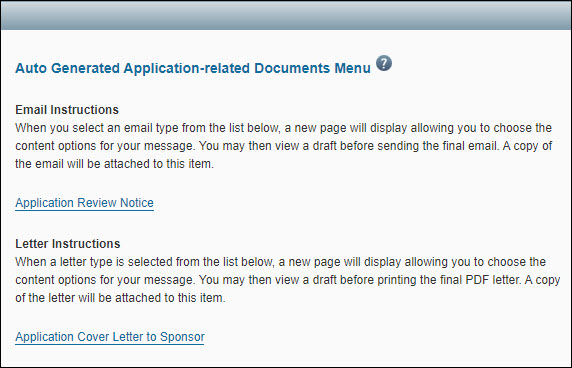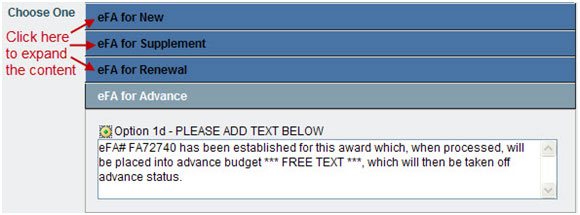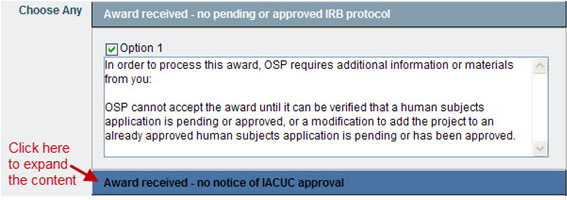A breadcrumb trail displays immediately under the “SPAERC” heading. The left-most choice is “Back to Spaerc Tasklist” which you can use to return to the last tasklist viewed. To the right of that is the item number. Click it to return to the page you see when you first open that type of item. In the case of an eGC1, the last part of the breadcrumb is the page being displayed.
The page heading displays just below the breadcrumb and includes the Short Title, the item ID, and the name of the PI. This appears on every page as a quick reference. The following image shows these heading parts.

This article covers:
Using the Action Bar

The icons on the action bar will vary depending on the item you are viewing, and whether the item is locked or unlocked.
Possible Icons in the Action Bar
 |
Save |
Writes any changes made to the database |
 |
Reset Form |
Clears any text entered on the page since the last save |
 |
Previous Page |
Displays the preceding page in an application |
 |
Next Page |
Displays the following page in an application |
Note: any time you navigate from one page to another, SPAERC saves any changes made to the item.
Within an application, the eGC1 pages contain a Previous link and a Continue button, which provide another way to navigate from page to page.
Using the Left Navigation Menu

The left navigation menu for an item generally contains “action” links such as change status, place or remove holds, save & close. For an application, you will also see links to view its pages, a summary, the approval graph and related approvals pages.
Using the Item Tabs
Use the set of tabs across the top of the main display area to access pages related to the item. Generally, you use the left-most tab to return to the page you see when you first open that item.
The following image shows the set of tabs for an application. The tabs are: Application, Funding Actions, Admin Actions, OSP Notes, Assignments, Status, Auto Generated Documents, and Cycle Details.

Applications, Funding Actions, and Admin Actions have the following tabs in common.
| Tab |
Description |
| OSP Notes |
Displays both system-generated notes and any that you add directly by using the text box on the page. For more details, see the OSP Notes Page article. |
| Assignments |
Used to reassign the item, and optionally some related items, to another individual within OSP. You can also view assignment history. For more details, see the Reassign an Item article. |
| Status |
Shows the history of status changes to the item from when it was initially created. For more details, see the Status article for the specific item type. |
| Auto Generated Documents |
Displays a page with email and/or letters you can use to communicate with the research team or the sponsor. See the Auto Generated Documents articles for more details. |
| Cycle Details |
When hovered over with the mouse, this tab displays a flyout list of this item’s cycle ID and all of that cycle’s related items. If no one has placed the item in a cycle yet, no list will appear. If you click the tab when there is no cycle, a pop-up window will appear with options for placing the item into a cycle. See the Cycles articles for more details. |
In addition to the common tabs, since Applications and Funding Actions can have related items (children), they have tabs for viewing a list of these items, and accessing them.
- Applications have a Funding Actions and an Admin Actions tab.
- Funding Actions have a Subawards and an Admin Actions tab.
Note: Use the Admin Actions tab to create a new Admin and/or Funding Action as a child of the current item.
Cycles have just the OSP Notes and Assignments tabs.
For messages that you often send to campus and sponsors, SPAERC provides a set of automatically generated documents (AGD) for you to customize.
A document is either an email which the system will send or a letter created as a PDF for printing. The system captures a copy of the communication and automatically attaches it to the related item.
For many of the documents, specific data from the item pre-populates email addresses, dates, sponsor names, proposal titles, and other information. You can edit this pre-populated information.
Available Auto Generated Documents
Applications
- Application Review Notice: use this email to send review comments to the Principal Investigator, Administrative Contact, Pre-Award Budget Contact, and eGC1 Preparer.
- Application Cover Letter to Sponsor: print this PDF-formatted letter and mail it to the sponsor in support of the application. The PDF file includes the UW letterhead. The eGC1 Campus Comments (entered in SAGE) display for reference at the top of the customization page. (They also appear on the Control Sheet.)
Funding Actions
- Notice of Award: use this email to send information about the award received to the Principal Investigator, Administrative Contact, Pre-Award Budget Contact, and eGC1 Preparer.
- Request for Activation Notice – fellowships: use this email to notify the PI of a fellowship award and request the PI to complete the Activation Notice.
- Research Agreement Acknowledgement: use this as a cover letter for the sponsor’s agreement sent to ensure the PI understands the terms. This is for industry sponsors.
- Sponsor Document Cover Letter: send this to the sponsor with the signed copies of the agreement.
Admin Actions
- SFI Compliance Notification: send this email to the PI about SFI disclosure for a budget extension.
- Sponsor Document Cover Letter: send this letter to the sponsor with the signed copies of the agreement.
Subawards
- Email Notification: send this email to the PI with attachments concerning the subaward.
- Notice to NIH: send this letter to NIH about the financial disclosures of the PI and the subrecipient.
- Cover Letter: send this letter to the subrecipient with the subaward agreement.
- Bilateral Modification/Amendment: send this email to the subrecipient with the appropriate attachments.
- Unilateral Modification/Amendment: send this email to the subrecipient with the appropriate attachments.
- Bilateral Subaward: send this email to the subrecipient with the appropriate attachments.
- Unilateral Subaward: send this email to the subrecipient with the appropriate attachments.
Create an Auto Generated Document
- From within an open item, click the Auto Generated Documents tab.
- The page will open and display a list of email and/or letter choices.
- To select the email message or letter you wish to create, click its link.

The email or letter draft will display. You can edit most of the suggested content.
Note: You will need to add content wherever you see three asterisks on either side of a description, such as *** FREE TEXT ***.
Document Section Types
- Pre-populated values such as the PI’s email address or the sponsor’s name and address. You may edit them if necessary.
-
- Paragraphs which may be complete as given, or may require the addition of specific information such as a date or amount of award.
For example, the Subject or Opening as shown in the following image.

- Choose One options allow you to select one section of content by clicking the radio button; you may edit the content. By default, some information is not displayed. To expand these sections, click the blue boxes.

- Choose Any options allow you to select one or more content sections by checking the box(es); after you select a section, you may edit the content.

Finalize and Send an Auto Generated Document
- After you have selected and edited the content, click the View Draft Email or View Draft PDF button to review the customized document. It will open in a separate window.
- You can close this window, make any necessary changes, and review the draft again, as needed.
- To create the final version of the document, click the Send Final Email or View Final PDF button.
- For email messages, you will need to confirm that you want send the email and attach it to the permanent record. The system will send the email message to the recipients and a copy to your email account. The final email will display in a separate window. A confirmation message will display in the main window.
- For letters, the final version displays as a PDF in a separate window. You may print the PDF and mail it.
View the Attached Copy of the Auto Generated Document
- For Applications, the document copy is attached in the Documents Uploaded by OSP section of the Attachments & Routing questions page. Campus user can view these attachments.
- For Funding Actions and Admin Actions, the system adds the document copy to the attachments area of the item. You may need to expand the attachments section to see the list of documents. Campus user can view these attachments in the Related Documents section of the application’s Attachments page.
Note:
- If you create another auto-generated document of the same type, the system will add it as a separate attachment.
- You cannot delete an attachment, but you can update it, depending on the item’s status











